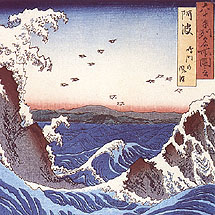| 4. The Sea |
 |

The water in seas and oceans
contains salt in a solution of more than 60 chemical elements.
The sea contains salt water, and covers 70% of the earth’s
surface.
One part of the colour spectrum in sunlight reflects off
the sea surface, the rest is absorbed. Blue is absorbed
more slowly than the others, so water in a deep ocean
is blue. The green colour near the coast comes from the
reflected vegetation.
The largest part of the planet’s biodiversity lives
in the sea.
|


[ enlarge image ] |
 |
| Giving reasons. When we want
to justify an opinion, we need to know our reasons.
We can also offer reasons for the beauty of a work
of art or an feature of nature. For example: "I
like the beauty of the sea. I like its changing
colours and shapes, the big waves during storms
and the little ones that barely make it to shore." |
| A) Decide whether you agree or not
with the following opinions. Give at least two reasons
for agreeing or disagreeing. |
| 1. |
I like living near the sea.
/ I like living in the countryside, etc. |
| 2. |
If it’s not forbidden,
it’s OK to do whatever you want at the
beach (or in the street, the park, etc.) |
| 3. |
I don't like finding rubbish
in the sea. |
| 4. |
I like the beauty of storms
at sea. |
|
| B) Ask about the beauty of other paintings
in ECODIALOGO |
|
 |

 |
| © Grup IREF 2003, with the support of the European Commission, DG XXII (Socrates/Comenius 3.2) |
[ print ] |
|
|
|
| 1. |
Water |
 |
| 2. |
Water cycle |
 |
3.
|
Water is essential for life
|
 |
| 4. |
The Sea |
 |
| 5. |
Rivers |
 |
| 6. |
Rain |
 |
| 7. |
Fish |
 |
8.
|
Water, a resource in danger |
 |
| 9. |
Saving water |
 |
10.
|
Life near the sea, life inland |
 |
| |
|